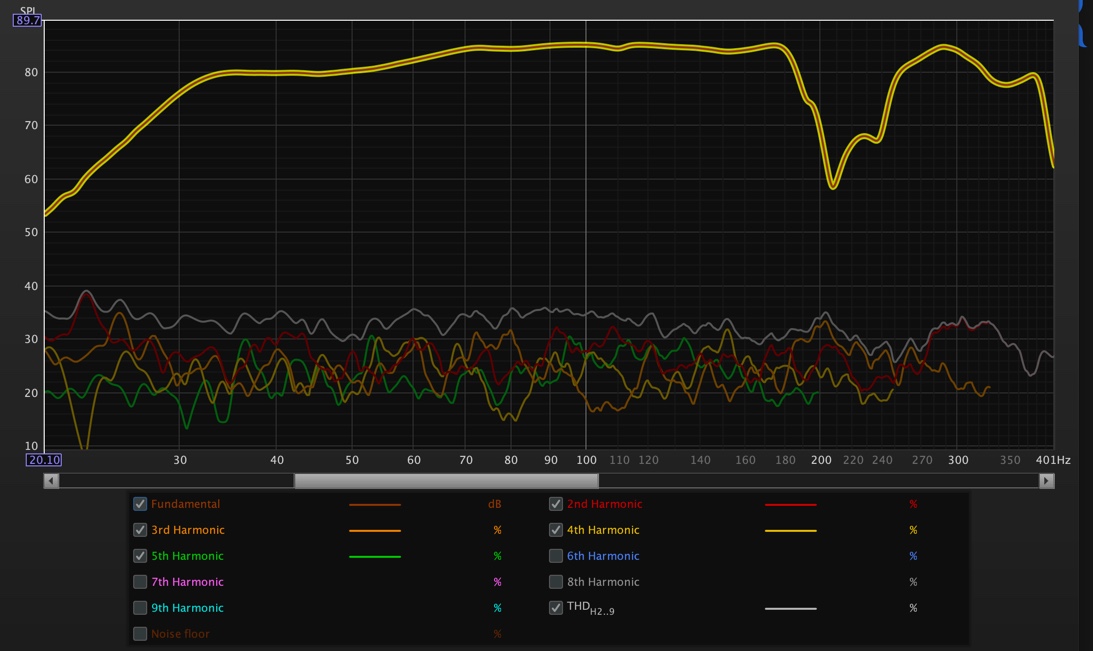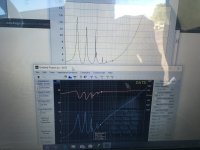How does it sound?
What is good and is there any drawbacks?
Is the "störning" in the cooperation between the bass and midbass section noticeable or does the damping smooth it out enough in your listening tests?
The measurements looks encouraging, but I am still a bit skeptical to parallel high order pure QW alignments.
I am not so sure your Monstera plant loves the "earthquakes" you subject it to. You might need to add some Perlite too the soil to keep it from becoming to compacted from the vibrations.
OK, I now think I have listened long enough to be able to say something about these boxes. I Cross them over at 150 Hz at 48 db/oct which cuts out the ringing at 180 Hz. For the TLBP6 I run a Yamaha P3200 amplifier that gives 2x340 W into 8 ohm.
It made a a huge difference to the soundstage and the stereo image when I brought the second speaker into the Room. I can't say I hear the cooperation problem that the un-dampened measurements shows. I do have some damping wool in both of them and they seem very well behaved. On the other hand, the room-acoustics is playing along quite a bit so to be honest there might be room for improvement on this part. I think that some critical outdoor listening and measurement is needed to pinpoint and figure it out.
Yesterday we had a DIY & vintage meeting where about 10 different DIY rigs where displayed. It was a lot of fun even though I missed you two Martinsson and Circlomanen. I listened to electrostats, magneplans, bass reflex, dipole, ripole, closed boxes and more. The last session of the day was mine.



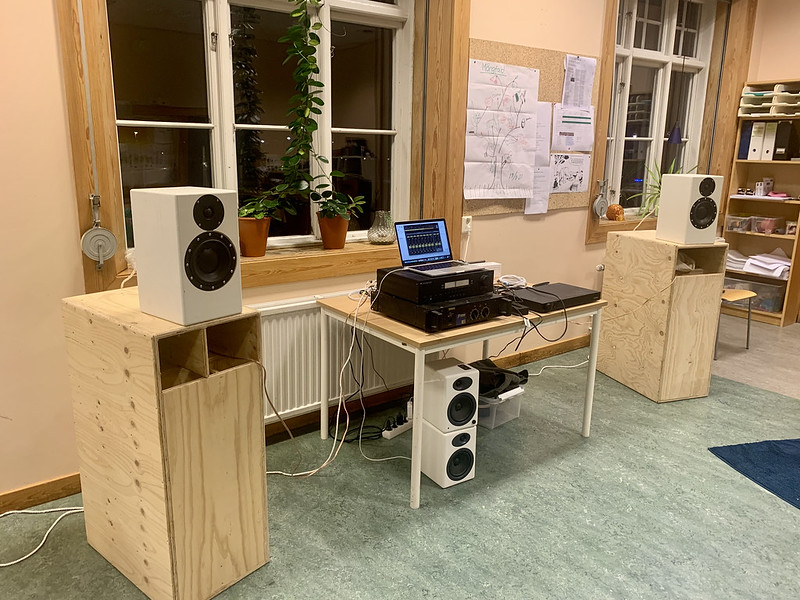
Despite that is was late in the day and people were getting tired, still, the room filled up with curious people who wanted to listen to what I had built. At first I har the bass turned up a bit to high but it gave effect. One of the first tracks we listened to was Nils Lofgren Band - Drum and Bass Intro. It is a tune where the TLBP6 really gets to shine and I got spontaneous applause when the song ended.
After a few songs I got a nudging feeling that people maybe have had enough. I asked if anyone would like to hear anything more and to my great joy they wanted more. The last tune of this hour long session was Infected Mushroom - Avratz. Its a long song (10 minutes). Halfway into it I faded the music and started to talk but was interrupted by the audience.
- Don’t stop the music, we want to listen to the end of the song too. And turn up the volume to max!
Well, said and done. I cranked the volume up as high as I dared. Higher than I ever played before. About 8 minutes into the song there is a crescendo with massive drums and bass. I could feel the floor underneath me vibrating and the windows were rattling…
I must be cautious with judging my own build as I am biased of cause. But, what a fantastic feeling. So much power, a physical experience that feels in the whole body rather than by the ears alone. Again, I am biased, but for what I can tell the bass is clean dry and precise. As for my current understanding and experience of the speakers, I couldn’t ask for more.
How they compare to THAM, ROAR or any other PARAFLEX I have no idea as I have never had the opportunity to listen to them. I hope there will come an opportunity to do so though. Listening and comparing would be very valuable to understand the different merits of the different construction principles.
Another fun Little episode occurred a few days ago. I had just gotten the second speaker in place and was playing on both of them for the first time. I cranked up the volume quite a bit and then my kids are coming up from the floor below, holding for the ears, asking if I were beating the crap out of some percussions…
Good or bad, I really dont know. All I know is that I love them
Last edited:
No problem, they will spit it right back out when you krank the volume upHaving the mouths point up that way is inviting something to fall in
Well, that is an appealing idea. Martinsson has suggested something like that too. I am not sure I’ve gotten my thought on room resonates right but I have this idea that standing waves between the roof and the floor, and between the side walls might be suppressed by having the speakers emanate from points that are 1/4 of the with of the room and 1/4 of the hight of the room. There off the placement of the mouth.Have you tried them with the mouths pointing down instead (on appropriate stands of course, perhaps to bring them up to the level of the of that cupboard that the other speakers are sitting on ?
I am also crossing them over at 150 Hz to get as much kick as possible from them. Pointing them down would require a slightly lower XO point to avoid negative interference between the TLBP6 and my tops.
What do you think, does this makes any sense?
Last edited:
There´s only one way to know, lets tryPositioning the vents pointing down would also reduce any "floor bounce" effect as well. You might end up with more output around the 150 Hz region...
Hi All,
a bit offtopic, but maybe interesting for you:
We're hosting a Pro-Audio Hackathon this weekend in Berlin, Germany.
We'll have 6x Paraflex C-2E "Golden Formular" and 3 21" builds: SKram by Josh Ricci, Isobaric Sub by B&C, Paraflex 21" C-2A.
And most likely 18"&21" Skoops from a dub/reggea soundsystem to measure & listen.
PM me if you're interested. It's free! =)
a bit offtopic, but maybe interesting for you:
We're hosting a Pro-Audio Hackathon this weekend in Berlin, Germany.
We'll have 6x Paraflex C-2E "Golden Formular" and 3 21" builds: SKram by Josh Ricci, Isobaric Sub by B&C, Paraflex 21" C-2A.
And most likely 18"&21" Skoops from a dub/reggea soundsystem to measure & listen.
PM me if you're interested. It's free! =)
Really nice sound!
It was a challenging big room that you filled with great music!
Thanks a lot for those kind and warming words. It means a coming from you.
Hi All,
a bit offtopic, but maybe interesting for you:
We're hosting a Pro-Audio Hackathon this weekend in Berlin, Germany.
We'll have 6x Paraflex C-2E "Golden Formular" and 3 21" builds: SKram by Josh Ricci, Isobaric Sub by B&C, Paraflex 21" C-2A.
And most likely 18"&21" Skoops from a dub/reggea soundsystem to measure & listen.
PM me if you're interested. It's free! =)
Thanks for the invite chrisBLN! I think I have seen something about this event on FB. I feel really flattered to be asked and I would love to come. Berlin is not that far from Gothenburg Sweden. Unfortunately I have obligations that weekend I can´t rescedule. It is to bad because your meeting would be a major contribution to my understanding of whats possible and not and to a more general understanding for producing high quality sound in the low region. Hope that you will write up some conclusions from the event.
Hi Forsman,
we'll make sure to document and publish as much data as we can after the event!
If you'll be in Berlin at any time in the future, feel free to reach out to me here or on fb - maybe we can arrange a listening-session.
This also applies for other curious people around berlin! ;-)
Cheers, c
we'll make sure to document and publish as much data as we can after the event!
If you'll be in Berlin at any time in the future, feel free to reach out to me here or on fb - maybe we can arrange a listening-session.
This also applies for other curious people around berlin! ;-)
Cheers, c
I am interested in hearing impressions of the SKRAM as I am working on a pair at the moment.Hi All,
a bit offtopic, but maybe interesting....=)
Hi Paulys55,
We'll especially test the SKram with 18 Sound's 21NTLW5000, as Josh Ricci mentioned that this driver simulates well in his cabinet. If time allows, we'll also test the other 21" drivers as well!
I just assembled the SKram for the Hackathon and I really like how compact it is. Also assembly was fast without any hickups. =)
We'll especially test the SKram with 18 Sound's 21NTLW5000, as Josh Ricci mentioned that this driver simulates well in his cabinet. If time allows, we'll also test the other 21" drivers as well!
I just assembled the SKram for the Hackathon and I really like how compact it is. Also assembly was fast without any hickups. =)
AWESOME thread! I can't believe I missed everything from the beginning.
Regarding Circlomanen's statement "every QW parallel bandpass design I have heard to date does have a problem in the upper part of the pass band," you should check out the Devastator thread on avsforum.com. Most of the variations are designed to play down to 16-18hz. The BP6P has a bump in the 80-100hz region for more musicality. Room gain kills the upper bass when BP's are designed with a flat response.
Regarding Circlomanen's statement "every QW parallel bandpass design I have heard to date does have a problem in the upper part of the pass band," you should check out the Devastator thread on avsforum.com. Most of the variations are designed to play down to 16-18hz. The BP6P has a bump in the 80-100hz region for more musicality. Room gain kills the upper bass when BP's are designed with a flat response.
AWESOME thread! I can't believe I missed everything from the beginning.
Regarding Circlomanen's statement "every QW parallel bandpass design I have heard to date does have a problem in the upper part of the pass band," you should check out the Devastator thread on avsforum.com. Most of the variations are designed to play down to 16-18hz. The BP6P has a bump in the 80-100hz region for more musicality. Room gain kills the upper bass when BP's are designed with a flat response.
I think he’s talking about the misalignment between the two parallel pipes at junction which often leaves a nasty discontinuity that’s overlooked or ignored but when you’re stuck with it…you’re stuck.. . It’s always got some ringing and craziness around it if not it’s just this area of disaster in certain songs that hit right there and then you’re stuck with it over and over till the next song or until you take the box out back and put it out of its misery with a shotgun
Forsmann got him a pair of nice ones here though.!!!

Too bad nothing picked up in that region, to study . but the signals just barely a flea fart in the hallway so it’s kind of tricky to figure these things out . The one I Add which part had a particularly obvious sliver in the response Had an obvious piggybacked Impedance at 96 /100 hz
Attachments
Yesterday I had the opportunity to make some more detailed measurements on my TLBP6. As we have discussed in this thread there might be a cooperation problem between the two pipes at around 110 Hz. One can see that in the simulation quite clearly.
To be able to chase the sweet spot for the length of the high tuned resonator (HTR) I have made an extra bottom for the HTR which I can wedge tight at any depth. By doing so I can adjust the length of the HTR in small incremental adjustments and see how it measures. Simulation and the final build will never be a 100% fit even though many times it is more than accurate enough.
The first measurement (at the top) is without any extra bottom and the HTR is roughly 8cm longer than simulated. I have then decreased the length of the HTR by approximately 2cm at the time and measured each length.
This figure gives an overview of where the cooperation problems occur. Disregard the ripple at 50Hz. It is interference from the laundry machine.

When one separates the curves it becomes more clear where the sweet spot is. All measurements are taken with the microphone at the mouth/port/exit of the speaker using a MiniDsp UMIK 1 and REW.
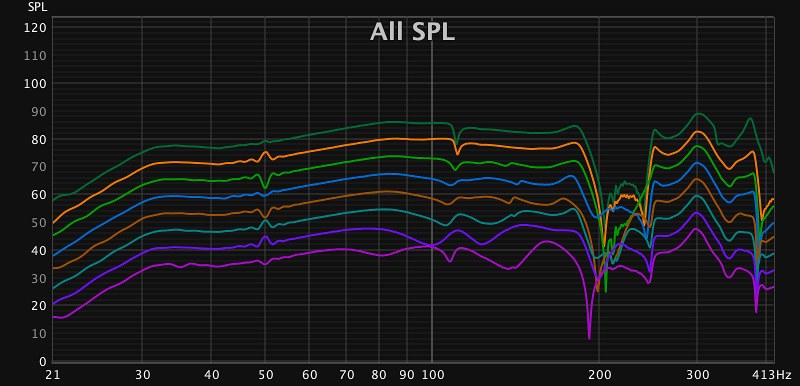
This is the length that I probably will use. The HTR in this measurement is just shy of 2cm shorter than what I have simulated. You can see it in the middle of the curves above. All measurements are without smoothing. I must say that I am rather pleased with a passband stretching from 30-190Hz. That is just over 2 ½ octaves. Not bad for a TL or a TH speaker. The phase looks nice too I think.

The waterfall diagram shows that the ringing at 110 Hz (cooperation area between the pipes) looks much better too. Although, there is a resonance at 50 Hz but that is the washing machine in an adjacent room

A sweep with the amplifier switched off still shows the resonance at 50 Hz so it does not come from the speaker itself.
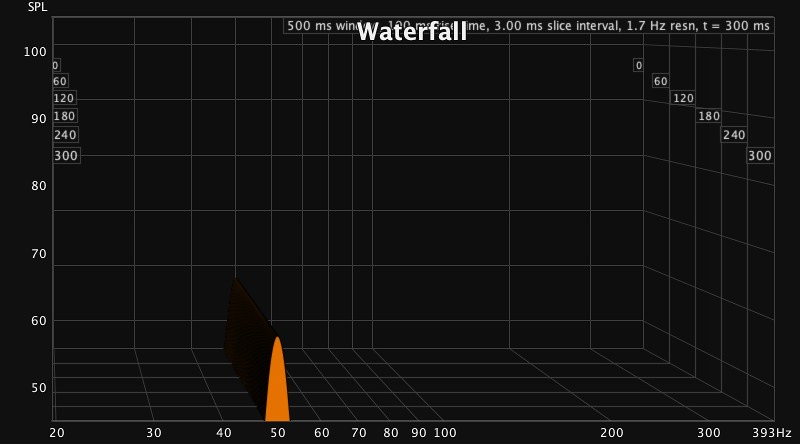
Finally a measurement of the distortion. A THD value of 0,241% seems quite good to me. Especially as the measurements were captured in not ideal conditions with quite some disturbing noise. Also, the average value is calculated on a larger dataset than the speaker will use in practical applications. Maybe I have to redo this measurement to see if it changes if the conditions are more favorable.
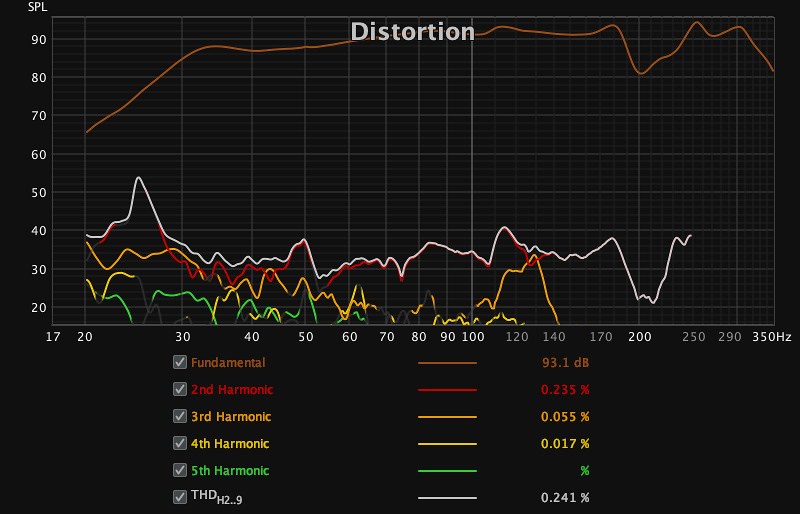
Group delay.

What I think I know is at what length of the HTR the speaker performs best at very low listening levels. What I don´t know is how it will behave at higher listening levels due to the nonlinear behavior of air at different pressures and aid particle velocities. Maybe that can be the next aspect of this to investigate.
The notch in both spl, phase and GD graph is a sign of a cooperation problem of the two resonators. It might not seem like a big problem, but every QW parallel bandpass design I have heard to date does have a problem in the upper part of the pass band.
Remember that the resonators will have different rate of change of tuning as a function of spl due to the nonlinear behavior of air at different pressures and aid particle velocities. This will exacerbate the problem greatly by making it a nonlinear pulsating flaw with the signal amplitude and frequency content.
To be able to chase the sweet spot for the length of the high tuned resonator (HTR) I have made an extra bottom for the HTR which I can wedge tight at any depth. By doing so I can adjust the length of the HTR in small incremental adjustments and see how it measures. Simulation and the final build will never be a 100% fit even though many times it is more than accurate enough.
The first measurement (at the top) is without any extra bottom and the HTR is roughly 8cm longer than simulated. I have then decreased the length of the HTR by approximately 2cm at the time and measured each length.
This figure gives an overview of where the cooperation problems occur. Disregard the ripple at 50Hz. It is interference from the laundry machine.

When one separates the curves it becomes more clear where the sweet spot is. All measurements are taken with the microphone at the mouth/port/exit of the speaker using a MiniDsp UMIK 1 and REW.

This is the length that I probably will use. The HTR in this measurement is just shy of 2cm shorter than what I have simulated. You can see it in the middle of the curves above. All measurements are without smoothing. I must say that I am rather pleased with a passband stretching from 30-190Hz. That is just over 2 ½ octaves. Not bad for a TL or a TH speaker. The phase looks nice too I think.

The waterfall diagram shows that the ringing at 110 Hz (cooperation area between the pipes) looks much better too. Although, there is a resonance at 50 Hz but that is the washing machine in an adjacent room

A sweep with the amplifier switched off still shows the resonance at 50 Hz so it does not come from the speaker itself.

Finally a measurement of the distortion. A THD value of 0,241% seems quite good to me. Especially as the measurements were captured in not ideal conditions with quite some disturbing noise. Also, the average value is calculated on a larger dataset than the speaker will use in practical applications. Maybe I have to redo this measurement to see if it changes if the conditions are more favorable.

Group delay.

What I think I know is at what length of the HTR the speaker performs best at very low listening levels. What I don´t know is how it will behave at higher listening levels due to the nonlinear behavior of air at different pressures and aid particle velocities. Maybe that can be the next aspect of this to investigate.
Last edited:
Not much to learn in The Facebook group. UnFortunately they’re not really into the science of things,
Or Figuring out how they work? Maybe they should ask circle man and Martinson for some help!!
. Too busy bandaiding they are chamber issues and they’re folding segment lengths are wrong , Abbreviated.. these things you have to look at in the sim so it’s not fair to say that unless people are looking at how it works. Then are on the same page, abd Understand this stuff. It seems nobody else does?
and all the models that I have no rhyme or reason. However some do come close, but then they seem to give it up in the excessive sizing of the larger chamber and screw the pooch again..
If they took the approach like or figuring out like, ‘circlomenen’is about roar And why it was so interesting and fun especially when he described how it worked would be extremely helpful but I don’t think anyone understands anythingBut Paraflex over there it was was merely discovered just by playing horn respone wizard mode.
many of the things circlomen was saying About the roar people didn’t understand. He often referred to a vortex or certain anomalies at the end of the initial pipe when entering the larger secondary chamber that threw people off, however you can see these things in the math and descriptions and engineering books @ exhaust systems as well. It’s quite interesting. But in the same books they describe assets and debt and stubs and how that works and how it’s a half wave length not a quarter in that section to the propagating wave versus a standing wave.
Then there’s a connection between all of this Phase and timing issue in these things or body to create gain or low pass filter by not screwing up the fees and alignment and harmonic intervals of proposing pipes in parallel or series
it’s 05238..
using one number to provide a perfect alignment in What’s the timing as swung on a pendulum OK 1 second interval. And the volume of a sphere with radius is 0.5. Also the hypotenuse of a rectangle (that’s perimeter of its base is pi ) with a perfect 2 to 1 ratio (0.5238/1.0476 , in the long and short legs . or effectively 30 6090° triangle sitting Across the long points The hypotenuse of 1.3095238.
As it turns out good for about a hundred years or so people have been using 0.3492 as the option to drive entry for transmission line speakers @the three-quarter harmonic void. It extended the pass band to the five/4, Fills that void because you’re excited to pipe in the section within effectively alters the face of that outgoing section when it rains at the other end.
The same thing is done in eight order pipes perfectly but even better so cause it’s coming from both sides and it’s absolutely positively got to be perfect or you get more and more that face anomaly. That area is prone to massive ringing and horrible reverb given the right freqs, or surprisingly much higher up versions of them that will stir up the pipe segment anyhow as a harmonic.. I could stir that up with a number of frequencies right now in a pipe I’ve used to study the stuff from the beginning, as can many people, actually those using Paraflex models from the group in boundary conditions. They don’t have issues and they become huge in certain situations.
But that doesn’t exist when you put these all into the right length precisely and stop thinking about advanced centerline . that doesn’t exist when you put these all into the right lengths and breaking that wave shape/math perfectly into 270 cm and 90 cm.
folding at each of those 90cm pats 180 degrees perfectly no extra no centerline no nothing the parallel walls are all separated by exactly 90 cm nothing else matters.
This is what you get in 360 cm . But that’s also what you get in the 300 separating and the two drivers entries.180 and 150 acoustical centers and they show up in the math they show up in the response . They show up even more in the details of response once it’s perfectly aligned and the CSa are appropriate.
I have never seen a better regular transmission line let alone a series 8th order or paranoid order then the ones that show up and in Regard to tiis. Can’t get anything better it couldn’t be more perfectly aligned and contributing in gain and low pass filter on each fold.
I don’t think anything can be more effective as a speaker? There’s none of the issues that Perflex inherently has it pertains even more of the con control it’s obvious the band with is beautiful and smooth as it can possibly be given the drivers test parameters and the chosen cross-section self dampening effect as well? Chauncey there’s lotta choices but there are numbers that work in this network over and over again every time.
What is the function of the 3060° triangle.
The other is the frequencies developed when describing a circle. Using circumference of the circle as the wave link you can draw around the circle assign wave on that circle in the harmonic intervals of the 270 of the 90 and the overlap perfectlyc I’ll also show you where the nodes are and wheve to fold . It’s beautiful it’s perfect in every way.
Even tunes to 28.8 330 or so depending on what’s the essay and how many drivers to use that will fit in the required space that will retain that phase in check.
Or Figuring out how they work? Maybe they should ask circle man and Martinson for some help!!
. Too busy bandaiding they are chamber issues and they’re folding segment lengths are wrong , Abbreviated.. these things you have to look at in the sim so it’s not fair to say that unless people are looking at how it works. Then are on the same page, abd Understand this stuff. It seems nobody else does?
and all the models that I have no rhyme or reason. However some do come close, but then they seem to give it up in the excessive sizing of the larger chamber and screw the pooch again..
If they took the approach like or figuring out like, ‘circlomenen’is about roar And why it was so interesting and fun especially when he described how it worked would be extremely helpful but I don’t think anyone understands anythingBut Paraflex over there it was was merely discovered just by playing horn respone wizard mode.
many of the things circlomen was saying About the roar people didn’t understand. He often referred to a vortex or certain anomalies at the end of the initial pipe when entering the larger secondary chamber that threw people off, however you can see these things in the math and descriptions and engineering books @ exhaust systems as well. It’s quite interesting. But in the same books they describe assets and debt and stubs and how that works and how it’s a half wave length not a quarter in that section to the propagating wave versus a standing wave.
Then there’s a connection between all of this Phase and timing issue in these things or body to create gain or low pass filter by not screwing up the fees and alignment and harmonic intervals of proposing pipes in parallel or series
it’s 05238..
using one number to provide a perfect alignment in What’s the timing as swung on a pendulum OK 1 second interval. And the volume of a sphere with radius is 0.5. Also the hypotenuse of a rectangle (that’s perimeter of its base is pi ) with a perfect 2 to 1 ratio (0.5238/1.0476 , in the long and short legs . or effectively 30 6090° triangle sitting Across the long points The hypotenuse of 1.3095238.
As it turns out good for about a hundred years or so people have been using 0.3492 as the option to drive entry for transmission line speakers @the three-quarter harmonic void. It extended the pass band to the five/4, Fills that void because you’re excited to pipe in the section within effectively alters the face of that outgoing section when it rains at the other end.
The same thing is done in eight order pipes perfectly but even better so cause it’s coming from both sides and it’s absolutely positively got to be perfect or you get more and more that face anomaly. That area is prone to massive ringing and horrible reverb given the right freqs, or surprisingly much higher up versions of them that will stir up the pipe segment anyhow as a harmonic.. I could stir that up with a number of frequencies right now in a pipe I’ve used to study the stuff from the beginning, as can many people, actually those using Paraflex models from the group in boundary conditions. They don’t have issues and they become huge in certain situations.
But that doesn’t exist when you put these all into the right length precisely and stop thinking about advanced centerline . that doesn’t exist when you put these all into the right lengths and breaking that wave shape/math perfectly into 270 cm and 90 cm.
folding at each of those 90cm pats 180 degrees perfectly no extra no centerline no nothing the parallel walls are all separated by exactly 90 cm nothing else matters.
This is what you get in 360 cm . But that’s also what you get in the 300 separating and the two drivers entries.180 and 150 acoustical centers and they show up in the math they show up in the response . They show up even more in the details of response once it’s perfectly aligned and the CSa are appropriate.
I have never seen a better regular transmission line let alone a series 8th order or paranoid order then the ones that show up and in Regard to tiis. Can’t get anything better it couldn’t be more perfectly aligned and contributing in gain and low pass filter on each fold.
I don’t think anything can be more effective as a speaker? There’s none of the issues that Perflex inherently has it pertains even more of the con control it’s obvious the band with is beautiful and smooth as it can possibly be given the drivers test parameters and the chosen cross-section self dampening effect as well? Chauncey there’s lotta choices but there are numbers that work in this network over and over again every time.
What is the function of the 3060° triangle.
The other is the frequencies developed when describing a circle. Using circumference of the circle as the wave link you can draw around the circle assign wave on that circle in the harmonic intervals of the 270 of the 90 and the overlap perfectlyc I’ll also show you where the nodes are and wheve to fold . It’s beautiful it’s perfect in every way.
Even tunes to 28.8 330 or so depending on what’s the essay and how many drivers to use that will fit in the required space that will retain that phase in check.
I agree with Petter, these results are really impressive, and I would like to add, hard to achive in resonant systems with out resorting to add on solutions. But that is not all, we are not only seeing a really impressive response plot without knowing what contributes to it, instead these results are fully transparent in the distortion and timedomains as well which validates the results on a level not often seen.
It would be intresting to see how does it behaves as we up the power, will there be an earlier onset of powercompression (doubtful given the sheer efficiency) or propagation losses given the folding (again doubtfull given the rather geneous CSA's), please note that this is my curisoity acting up only, not an invite to go ahead and try to figure it out, you have certainly put forward more then enough data already
Thank you for sharing this Forman, really impressive, stand tall!
It would be intresting to see how does it behaves as we up the power, will there be an earlier onset of powercompression (doubtful given the sheer efficiency) or propagation losses given the folding (again doubtfull given the rather geneous CSA's), please note that this is my curisoity acting up only, not an invite to go ahead and try to figure it out, you have certainly put forward more then enough data already
Thank you for sharing this Forman, really impressive, stand tall!
Good to hear from you Petter.Really nice Forsman! I can not recall I've seen such clean and extended band width of any resonant system. Anywhere. Not only is it extended, no peaks are present above the band pass either.
Very interesting to get your thoughts on the design. These two sentences really put things in perspective.
Thank you so much martinsson. You are too kind! I don't think I have done anything remarkable. All I have done is to design, build and share thoughts and measurements. That is exactly what both of you do your selves. That kind of information is very valuable for anyone that is trying to figure out how things work. I post stuff and try to be transparent to get feedback and through that develop my own understanding. Also, I hope that others can learn from it in the same way I do. That's all there is to itI agree with Petter, these results are really impressive, and I would like to add, hard to achive in resonant systems with out resorting to add on solutions. But that is not all, we are not only seeing a really impressive response plot without knowing what contributes to it, instead these results are fully transparent in the distortion and timedomains as well which validates the results on a level not often seen.
It would be intresting to see how does it behaves as we up the power, will there be an earlier onset of powercompression (doubtful given the sheer efficiency) or propagation losses given the folding (again doubtfull given the rather geneous CSA's), please note that this is my curisoity acting up only, not an invite to go ahead and try to figure it out, you have certainly put forward more then enough data already
Thank you for sharing this Forman, really impressive, stand tall!
- Home
- Loudspeakers
- Subwoofers
- TLBP6 - Paraflex
